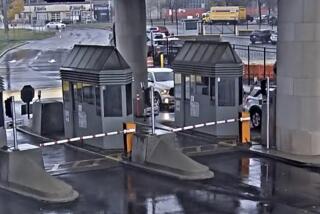Possible Clue Found in Probe of Derailment
- Share via
Federal investigators probing the wreckage of the fatal Feb. 1 freight train derailment in the Cajon Pass have discovered that a control lever on one of the wrecked cars had been moved into a position that could have crippled some of the train’s brakes, sources said Monday.
Whether the lever had been moved deliberately in a possible attempt to sabotage the train has not been determined, the sources said. They said there is a good possibility that the lever could have been moved by the crash’s impact.
The control lever and other parts of the car are being shipped to a National Transportation Safety Board laboratory in Washington in an attempt to determine how the lever--which turns a valve called an “angle cock”--was moved. Because of the possibility of sabotage, the FBI has joined the investigation.
The angle cock is part of the complex system, invented by George Westinghouse, that has been the primary means of braking freight and passenger trains for almost 125 years.
Understanding the significance of the lever’s position--and why the FBI is so interested--requires a brief course in air-brake technology:
The Westinghouse brake system uses air pressure, generated by the locomotive, that is pumped the length of the train through pipes and hoses. This air line fills reservoirs on each of the cars.
Once the system is pressurized, the air line serves as the control mechanism. When the engineer releases some of the pressure in the air line, the drop in line pressure signals the reservoirs to release some of their air. The air from the reservoirs pushes pistons that press brake shoes against the wheels.
This system has a safety feature: If the air line is somehow severed, the brakes are automatically applied. But trainmen soon realized that some sort of valve was needed to shut off the air at the coupling before a car was uncoupled. Otherwise, uncoupling a car would bleed off the air and lock all the brakes on the locomotive and the cars still coupled to it.
That valve is the angle cock, which is controlled by a lever on the side of the car.
Sources said that as NTSB investigators sorted through the mangled wreckage, they found a car on which the angle cock was closed. If someone had closed the car’s angle cock during the train’s brief stop before descending the grade, then the engineer’s brake commands--delivered through the air line--would stop at the valve, and all the cars behind it would have been without brakes.
It was the closed angle cock lever--not a signal that had been tampered with, as sources earlier had believed--that suggested the possibility of sabotage and prompted the NTSB to call in the FBI.
However, the sources said, the angle cock lever could have been moved to the closed position by the impact of the crash, and not before it. Furthermore, they said, the car probably was far enough back on the train so the operable brakes could have been sufficient to stop it.
Nevertheless, even though they have not yet determined what caused the crash, investigators say there apparently was some sort of air brake failure as the heavily laden Burlington Northern Santa Fe freight train started down the treacherous grade and accelerated out of control. Two crewmen were killed and a third was injured when the train plunged from the rails on a curve and burst into flames.
The Federal Railroad Administration said it appeared that the air line had somehow become blocked, and that a radio-controlled emergency bypass system that could have applied the brakes beyond the blockage had not been activated. The railroad agency declined comment on the reports that a closed angle cock might have caused the blockage.
The train’s secondary braking system, which uses the locomotives’ electric motors, would not have been sufficient to stop the train.
Sources said the FBI is looking at other evidence besides the angle cock lever, but agents declined to elaborate.
Last week, the railroad agency sharply criticized the Burlington Northern Santa Fe’s safety procedures and issued an emergency order requiring trains such as the one that crashed to have a working and fully activated bypass system so the engineer can apply the brakes at the rear of the train, even if there is a blockage in the air line.
More to Read
Sign up for Essential California
The most important California stories and recommendations in your inbox every morning.
You may occasionally receive promotional content from the Los Angeles Times.













